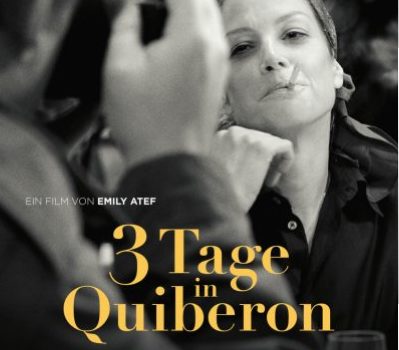
When her best friend, Hilde, rings Romy Schneider out of the hotel bed, she is still dizzy. Her condition was low, so the better that her old friend has come. First of all, they enjoy spending time together, a rarity, because leisure time was little granted to Romy. She was an exceptional artist, a class of her own, who remained a “Sissi” all her life in Germany and Austria, which did not do her justice at all.
The film shows Romy Schneider, the woman. It tells of three days in 1981 in a small town on the French coast, Quiberon in the Bretagne. Romy took these days off to recover from her busy life, a little break before her next film project, “Swimming Pool”, or “La Piscine”. She wants to refuel, to get fit for her son David. Despite her eternal cat and mouse game with the press, the star allowed an exeptional interview. Photographer Robert Lebeck, whom she called “Lebo,” and Romy know each other from before. In him she found a sensitive companion and a relationship of trust that led to the unique photos in Quiberon. Lebeck not only captured the world star with the camera. “It often happened that you ran open doors at Romy, and immediately behind hit a concrete wall,” he said in a retrospect in 1998. Lebeck and Romy are fooling around on the beach, creating photos of lightness and lust for life that the then 42-year-old star was lacking at the time. She was more or less broke. The divorce with Daniel Biasini stood in the house and she had landed on a dangerous health spiral; Tablets and alcohol, a poisonous mix. The german Star-Magazin “der Stern” sent Lebeck, together with the journalist Michael Jürgs for a title story, and Romy unwinds her usual press repertoire, until the two get to know each other. During the evening in the village pub, spending time within the group, the ice melts.
Romy Schneider drops all barriers, there is no longer any distance between her and the journalists, although Jürgs’ interview questions asked for today’s standards in terms of content and style: “Romy, you are a thrill of public annoyance, what does your son actually say to that…”
But maybe it were just these sharp questions that made the  Quiberon interview an important document in Romy Schneider’s biography. Frapping confessions and complete, almost therapeutic “surrender” to the questioner: The great crisis of her life, the tormenting dilemma between exceptional artist and mother, a highly gifted, sensitive woman in all her contradictions, but generally raises the question of the tension between public and private person. Her life as a projection surface, she as an artist and private person. At the beginning of the 1960s she went from Berlin to Paris with a clear mind, not “fled”: “I wanted to live!”, she says, from the patronage of a pure adult world she finally felt free …
Quiberon interview an important document in Romy Schneider’s biography. Frapping confessions and complete, almost therapeutic “surrender” to the questioner: The great crisis of her life, the tormenting dilemma between exceptional artist and mother, a highly gifted, sensitive woman in all her contradictions, but generally raises the question of the tension between public and private person. Her life as a projection surface, she as an artist and private person. At the beginning of the 1960s she went from Berlin to Paris with a clear mind, not “fled”: “I wanted to live!”, she says, from the patronage of a pure adult world she finally felt free …
It was the last big interview Romy gave. Shortly thereafter, her son David died through a tragic accident at his grandparents in Paris. Romy still turns the walker from Sans-Souci. In 1982, Romy Schneider died in her apartment in Paris.
The sw movie pulls you into the spell of these years. Marie Bäumer, also a German actress living in Paris, plays the Romy very convincingly. In the end, the Weltstarsie is definitely no longer a Sissi, a stigma of the past she was not amused of…
Tags: 3 days in Quiberon Romy Schneider












